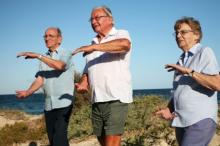Tai chi improved postural stability and other functional outcomes in patients with mild to moderate Parkinson’s disease to a significantly greater extent than did resistance training over the course of a 6-month period in a randomized, controlled trial.
The number of falls among patients who performed tai chi also significantly declined, making the clinical trial the first to demonstrate the efficacy of an exercise intervention in decreasing falls among Parkinson’s patients, Fuzhong Li, Ph.D., of the Oregon Research Institute, Eugene, and his associates reported in the Feb. 9 issue of the New England Journal of Medicine.
Tai chi is a balance-based exercise that has been demonstrated to improve strength and physical function in the elderly, as well as to improve the axial symptoms of Parkinson’s disease (PD) in two pilot studies.
Dr. Li and his colleagues enrolled 195 participants, aged 40-85 years, in four Oregon cities for 6 months of twice-weekly 1-hour tai chi classes, resistance-training classes, or low-impact stretching classes. They had Hoehn and Yahr scale scores of 2-4 out of a possible 5, indicating mild to moderate PD severity.
Sixty-five study subjects were randomly assigned to the tai chi program, which was deliberately designed to tax balance and gait. It stressed "weight shifting and ankle sway to effectively move the person’s center of gravity toward the limits of stability, alternating between a narrow stance and a wide stance to continually change the base of support, increasing support-leg standing time and trailing-leg swing time, engaging rotational trunk movements with upright posture, and performing heel-to-toe (forward) and toe-to-heel (backward) stepping movements to strengthen dorsiflexion and plantar flexion."
Another 65 subjects were assigned to resistance training, in which gradually increasing ankle weights and weighted vests were worn while the patients performed forward and side steps, squats, forward and side lunges, and heel and toe raises. These exercises focused on strengthening the muscles that are important for posture, balance, and gait.
The final 65 subjects were assigned to a variety of seated and standing stretches involving gentle trunk rotation and joint extension and flexion in the neck, upper back, shoulders, arms, quadriceps, hamstrings, calves, and hips. This was considered a control condition and was intended to provide similar social interaction as the other interventions without the training benefits.
The primary outcome measure was improvement in two indicators of postural stability, maximum excursion and directional control, which were measured using computerized dynamic posturography at baseline, 3 months, 6 months (the conclusion of the intervention), and 3 months after the end of the intervention. "Maximum excursion is an assessment of the limits of self-initiated movements as patients shift or lean their center of gravity, without falling, toward the theoretical limit (100%) in each of eight target directions. Directional control, a measure of movement accuracy, is calculated by comparing the amount of movement toward the target with the amount of extraneous movement," the investigators explained.
After the 6-month intervention, the tai chi group performed significantly better in both of those measures than did the other two groups. Between baseline and 6 months, the tai chi group improved by an average of about 10 percentage points on maximum excursion and 8 percentage points on directional control, while the strength-training group improved by 4 percentage points on maximum excursion but did not improve significantly on directional control. The stretching group showed no improvement in either measure, the investigators said (N. Engl. J. Med. 2012;366:511-9).
The tai chi group also performed significantly better than did the other two study groups in the secondary outcomes of gait (stride length and walking velocity); strength of knee extensors and flexors; reach (the maximal distance the patient could reach forward beyond arm’s length while maintaining a fixed standing position); and mobility (the time taken to rise from a chair, walk 3 meters, return, and sit down).
These results suggest that tai chi "reduced dyskinesia by increasing the ability of the participants to adopt effective sway strategies (at the ankle or hip), engage in controlled movements with improved balance control near the limit of stability, or both," according to the investigators. In practical terms, patients could more effectively perform the tasks of daily living, such as reaching forward to take items from a cabinet, rising from a chair, and walking.
Perhaps as important, the rate of falls during the study period was lower in the tai chi group (0.22/subject-month) than in the resistance training group (0.51) and in the stretching group (0.62). There were a total of 62 falls among 19 participants in the tai chi group, 133 among 31 participants in the resistance group, and 186 among 26 participants in the stretching group.


